Environmentally Sustainable Green Roof Design for Energy Demand Reduction
Abstract
1. Introduction
- A more energy-efficient building;
- An improved and landscaped building and an attraction for the university community and citizens with the following agenda: reflecting the commitment of the UPV/EHU to the needs of Basque society as well as those derived from its history and its socioeconomic, political, and cultural transformations; disseminating the knowledge of universal culture and science; and exercising its daily activity in an economically, socially, and environmentally sustainable manner (UPV/EHU Strategic Plan 2022–2025). The new plan defines the public university as “a decisive agent for the development of the Basque community” as well as “a space for the generation of new ideas”;
- The valorization of waste generated in the canteen of the same building through composting in pursuit of the principles of openness and dissipation of ecosystems, hierarchy, self-sufficiency, and zero waste.
2. Materials and Methods
2.1. Experimental Site Description
- -
- Perlite is a material obtained as a result of the thermal treatment of volcanic siliceous rock of the rhyolite group at 1000–1200 °C. It is presented as white particles whose dimensions vary between 1.5 and 6 mm with a low density and are generally less than 100 kg/m3. It has a water retention capacity of up to five times its weight and a high porosity; its pH is close to neutral (7–7.5);
- -
- Vermiculite is obtained by exfoliating a type of mica at temperatures above 800 °C. It has an apparent density of 90 to 140 kg/m3 and is supplied in 5–10 mm flakes. It can hold 350 L of water per cubic meter and has a good aeration capacity, although it tends to compact over time. It can contain up to 8% assimilable potassium and up to 12% assimilable magnesium. Its pH is close to neutral (7–7.2);
- -
- Sand: The grain size of the sand ranges from 0.5 to 2 mm in diameter. Its bulk density is similar to that of gravel. Its water retention capacity is medium (20% by weight and more than 35% by volume); its aeration capacity decreases over time due to compaction;
- -
- Gravel has a diameter of between 5 and 15 mm and an apparent density of between 1500 and 1800 kg/m3. It has good structural stability; its water retention capacity is low although its porosity is high (more than 40% of the volume).
2.2. Waste Measurements
2.3. Calculation of Green Cover Efficiency
- Tg is the measured temperature of the exterior surface of a monitored building. It might be a vertical or a horizontal component [69].
- The maximum temperature (Tmax) can be calculated using the experimental method provided by ASHRAE [72] which calls it Tsol-air.
- The term α/hcomb has a value of 0.052, which represents the usual maximum value for this term;
- The term (ε∙∆R)/hcomb has a value for horizontal surfaces facing the sky of 4 °C and for vertical surfaces of 0 °C;
- While the minimum temperature, considered as the ‘wet bulb temperature’, can be obtained using the outdoor temperature and relative humidity [73], Tmin is defined as the temperature of the air when it is adiabatically saturated with water, in which case its temperature will decrease to the temperature called the wet bulb temperature. This, in turn, can be calculated as a function of the outdoor air temperature and the relative humidity, using the following empirical algorithm [74].
2.4. Calculation of the Energy Demand after the Installation of a Vegetation Cover
3. Results and Discussion
3.1. Efficiency Result and Meteorological Conditions for a Dry Summer Period
3.2. Efficiency Result and Meteorological Conditions for a Wet Summer Period
3.3. Efficiency Result and Meteorological Conditions for a Wet Winter Period
3.4. Energy Savings of a Sustainable Green Roof
3.4.1. Summer Period
3.4.2. Winter Period
3.5. Limitations
4. Conclusions
Author Contributions
Funding
Data Availability Statement
Acknowledgments
Conflicts of Interest
References
- Haseeb, M.; Kot, S.; Hussain, H.I.; Jermsittiparsert, K. Impact of Economic Growth, Environmental Pollution, and Energy Consumption on Health Expenditure and R&D Expenditure of ASEAN Countries. Energies 2019, 12, 3598. [Google Scholar]
- Krellenberg, K.; Welz, J.; Link, F.; Barth, K. Urban vulnerability and the contribution of socio-environmental fragmentation. Prog. Hum. Geogr. 2017, 41, 408–431. [Google Scholar] [CrossRef]
- Chen, M.; Chen, L.; Cheng, J.; Yu, J. Identifying interlinkages between urbanization and Sustainable Development Goals. Geogr. Sustain. 2022, 3, 339–346. [Google Scholar] [CrossRef]
- Raji, B.; Tenpierik, M.J.; van den Dobbelsteen, A. The impact of greening systems on building energy performance: A literature review. Renew. Sustain. Energy Rev. 2015, 45, 610–623. [Google Scholar] [CrossRef]
- Chen, D.; Wang, X.; Thatcher, M.; Barnett, G.; Kachenko, A.; Prince, R. Urban vegetation for reducing heat related mortality. Environ. Pollut. 2014, 192, 275–284. [Google Scholar] [CrossRef]
- Mihalakakou, G.; Souliotis, M.; Papadaki, M.; Menounou, P.; Dimopoulos, P.; Kolokotsa, D.; Paravantis, J.A.; Tsangrassoulis, A.; Panaras, G.; Giannakopoulos, E.; et al. Green roofs as a nature-based solution for improving urban sustainability: Progress and perspectives. Renew. Sustain. Energy Rev. 2023, 180, 113306. [Google Scholar] [CrossRef]
- World Cities Report 2020: The Value of Sustainable Urbanization; United Nations Human Settlements Programme (UN-Habitat): Nairobi, Kenya, 2020.
- The 15 Circular Steps for Cities, 2nd ed.; European Investment Bank: Luxembourg, 2021.
- Bianchini, F.; Hewage, K. How “green” are the green roofs? Lifecycle analysis of green roof materials. Build. Environ. 2012, 48, 57–65. [Google Scholar] [CrossRef]
- Shafique, M.; Kim, R.; Rafiq, M. Green roof benefits, opportunities and challenges—A review. Renew. Sustain. Energy Rev. 2018, 90, 757–773. [Google Scholar] [CrossRef]
- Zambrano-Prado, P.; Pons-Gumí, D.; Toboso-Chavero, S.; Parada, F.; Josa, A.; Gabarrell, X.; Rieradevall, J. Perceptions on barriers and opportunities for integrating urban agri-green roofs: A European Mediterranean compact city case. Cities 2021, 114, 103196. [Google Scholar] [CrossRef]
- Iaria, J.; Susca, T. Analytic Hierarchy Processes (AHP) evaluation of green roof- and green wall-based UHI mitigation strategies via ENVI-met simulations. Urban Clim. 2022, 46, 101293. [Google Scholar] [CrossRef]
- Bruno, R.; Bevilacqua, P.; Arcuri, N. 10—Green roofs as passive system to moderate building cooling requirements and UHI effects: Assessments by means of experimental data. In Eco-Efficient Materials for Reducing Cooling Needs in Buildings and Construction; Pacheco-Torgal, F., Czarnecki, L., Pisello, A.L., Cabeza, L.F., Granqvist, C., Eds.; Woodhead Publishing: Sawston, UK, 2021; pp. 205–245. [Google Scholar]
- Liu, W.; Engel, B.A.; Chen, W.; Wei, W.; Wang, Y.; Feng, Q. Quantifying the contributions of structural factors on runoff water quality from green roofs and optimizing assembled combinations using Taguchi method. J. Hydrol. 2021, 593, 125864. [Google Scholar] [CrossRef]
- Liao, W.; Drake, J.; Thomas, S.C. Biochar granulation, particle size, and vegetation effects on leachate water quality from a green roof substrate. J. Environ. Manag. 2022, 318, 115506. [Google Scholar] [CrossRef] [PubMed]
- Castleton, H.F.; Stovin, V.; Beck, S.B.M.; Davison, J.B. Green roofs; building energy savings and the potential for retrofit. Energy Build. 2010, 42, 1582–1591. [Google Scholar] [CrossRef]
- Parizotto, S.; Lamberts, R. Investigation of green roof thermal performance in temperate climate: A case study of an experimental building in Florianópolis city, Southern Brazil. Energy Build. 2011, 43, 1712–1722. [Google Scholar] [CrossRef]
- Kazemi, M.; Courard, L.; Attia, S. Water permeability, water retention capacity, and thermal resistance of green roof layers made with recycled and artificial aggregates. Build. Environ. 2023, 227, 109776. [Google Scholar] [CrossRef]
- Pérez, G.; Coma, J.; Solé, C.; Castell, A.; Cabeza, L.F. Green roofs as passive system for energy savings when using rubber crumbs as drainage layer. Energy Procedia 2012, 30, 452–460. [Google Scholar] [CrossRef]
- Schroll, E.; Lambrinos, J.; Righetti, T.; Sandrock, D. The role of vegetation in regulating stormwater runoff from green roofs in a winter rainfall climate. Ecol. Eng. 2011, 37, 595–600. [Google Scholar] [CrossRef]
- Susca, T.; Zanghirella, F.; Colasuonno, L.; Del Fatto, V. Effect of green wall installation on urban heat island and building energy use: A climate-informed systematic literature review. Renew. Sustain. Energy Rev. 2022, 159, 112100. [Google Scholar] [CrossRef]
- D’Agostino, D.; de Rossi, F.; Marigliano, M.; Marino, C.; Minichiello, F. Evaluation of the optimal thermal insulation thickness for an office building in different climates by means of the basic and modified “cost-optimal” methodology. J. Build. Eng. 2019, 24, 100743. [Google Scholar] [CrossRef]
- Vellei, M.; Ramallo-González, A.P.; Coley, D.; Lee, J.; Gabe-Thomas, E.; Lovett, T.; Sukumar, N. Overheating in vulnerable and non-vulnerable households. Build. Res. Inf. 2017, 45, 102–118. [Google Scholar] [CrossRef]
- Rodrigues, E.; Fernandes, M.S. Overheating risk in Mediterranean residential buildings: Comparison of current and future climate scenarios. Appl. Energy 2020, 259, 114110. [Google Scholar] [CrossRef]
- Rodrigues, E.; Fereidani, N.A.; Fernandes, M.S.; Gaspar, A.R. Climate change and ideal thermal transmittance of residential buildings in Iran. J. Build. Eng. 2023, 74. [Google Scholar] [CrossRef]
- Jaffal, I.; Ouldboukhitine, S.; Belarbi, R. A comprehensive study of the impact of green roofs on building energy performance. Renew. Energy 2012, 43, 157–164. [Google Scholar] [CrossRef]
- Algarni, S.; Almutairi, K.; Alqahtani, T. Investigating the performance of energy management in office buildings by using a suitable green roof design to reduce the building’s energy consumption. Sustain. Energy Technol. Assess. 2022, 54, 102825. [Google Scholar] [CrossRef]
- Azkorra-Larrinaga, Z.; Erkoreka-González, A.; Martín-Escudero, K.; Pérez-Iribarren, E.; Romero-Antón, N. Thermal characterization of a modular living wall for improved energy performance in buildings. Build. Environ. 2023, 234, 110102. [Google Scholar] [CrossRef]
- Coma, J.; Pérez, G.; Solé, C.; Castell, A.; Cabeza, L.F. Thermal assessment of extensive green roofs as passive tool for energy savings in buildings. Renew. Energy 2016, 85, 1106–1115. [Google Scholar] [CrossRef]
- Cirrincione, L.; Marvuglia, A.; Scaccianoce, G. Assessing the effectiveness of green roofs in enhancing the energy and indoor comfort resilience of urban buildings to climate change: Methodology proposal and application. Build. Environ. 2021, 205, 108198. [Google Scholar] [CrossRef]
- Susca, T. Green roofs to reduce building energy use? A review on key structural factors of green roofs and their effects on urban climate. Build. Environ. 2019, 162, 106273. [Google Scholar] [CrossRef]
- He, H.; Jim, C.Y. Simulation of thermodynamic transmission in green roof ecosystem. Ecol. Model. 2010, 221, 2949–2958. [Google Scholar] [CrossRef]
- Pérez, G.; Rincón, L.; Vila, A.; González, J.M.; Cabeza, L.F. Green vertical systems for buildings as passive systems for energy savings. Appl. Energy 2011, 88, 4854–4859. [Google Scholar] [CrossRef]
- Morakinyo, T.E.; Dahanayake, K.W.D.K.C.; Ng, E.; Chow, C.L. Temperature and cooling demand reduction by green-roof types in different climates and urban densities: A co-simulation parametric study. Energy Build. 2017, 145, 226–237. [Google Scholar] [CrossRef]
- Rakotondramiarana, H.; Ranaivoarisoa, T.; Morau, D. Dynamic Simulation of the Green Roofs Impact on Building Energy Performance, Case Study of Antananarivo, Madagascar. Buildings 2015, 5, 497–520. [Google Scholar] [CrossRef]
- Belgium: NERA Contributes Policy and Macroeconomic Analysis on the Circular Economy in a New Study from the Ellen MacArthur Foundation: Delivering the Circular Economy a Toolkit for Policymakers. TendersInfo News. 2015. Available online: https://ellenmacarthurfoundation.org/a-toolkit-for-policymakers (accessed on 20 June 2023).
- Gajalakshmi, S.; Abbasi, S.A. Solid Waste Management by Composting: State of the Art. Crit. Rev. Environ. Sci. Technol. 2008, 38, 311–400. [Google Scholar] [CrossRef]
- Bruni, C.; Akyol, Ç.; Cipolletta, G.; Eusebi, A.L.; Caniani, D.; Masi, S.; Colón, J.; Fatone, F. Decentralized Community Composting: Past, Present and Future Aspects of Italy. Sustainability 2020, 12, 3319. [Google Scholar] [CrossRef]
- Brusselaers, J.; Van Der Linden, A. Bio-Waste in Europe—Turning Challenges into Opportunities; European Environment Agency: Copenhagen, Denmark, 2020.
- Awasthi, M.K.; Duan, Y.; Awasthi, S.K.; Liu, T.; Zhang, Z. Effect of biochar and bacterial inoculum additions on cow dung composting. Bioresour. Technol. 2020, 297, 122407. [Google Scholar] [CrossRef]
- Sayara, T.; Basheer-Salimia, R.; Hawamde, F.; Sánchez, A. Recycling of Organic Wastes through Composting: Process Performance and Compost Application in Agriculture. Agronomy 2020, 10, 1838. [Google Scholar] [CrossRef]
- Cerda, A.; Artola, A.; Font, X.; Barrena, R.; Gea, T.; Sánchez, A. Composting of food wastes: Status and challenges. Bioresour. Technol. 2018, 248, 57–67. [Google Scholar] [CrossRef]
- Torrijos, V.; Calvo Dopico, D.; Soto, M. Integration of food waste composting and vegetable gardens in a university campus. J. Clean. Prod. 2021, 315, 128175. [Google Scholar] [CrossRef]
- Araújo de Almeida, M.; Colombo, R. Construction of green roofs via using the substrates made from humus and green coconut fiber or sugarcane bagasse. Sustain. Chem. Pharm. 2021, 22, 100477. [Google Scholar] [CrossRef]
- Kumar, S. Composting of municipal solid waste. Crit. Rev. Biotechnol. 2011, 31, 112–136. [Google Scholar] [CrossRef]
- Huang, D.; Gao, L.; Cheng, M.; Yan, M.; Zhang, G.; Chen, S.; Du, L.; Wang, G.; Li, R.; Tao, J.; et al. Carbon and N conservation during composting: A review. Sci. Total Environ. 2022, 840, 156355. [Google Scholar] [CrossRef] [PubMed]
- Tirkolaee, E.B.; Mahdavi, I.; Esfahani, M.M.S.; Weber, G. A robust green location-allocation-inventory problem to design an urban waste management system under uncertainty. Waste Manag. 2020, 102, 340–350. [Google Scholar] [CrossRef]
- Yu, K.H.; Zhang, Y.; Li, D.; Montenegro-Marin, C.E.; Kumar, P.M. Environmental planning based on reduce, reuse, recycle and recover using artificial intelligence. Environ. Impact Assess. Rev. 2021, 86, 106492. [Google Scholar] [CrossRef]
- Bui, T.; Tseng, J.; Tseng, M.; Lim, M.K. Opportunities and challenges for solid waste reuse and recycling in emerging economies: A hybrid analysis. Resour. Conserv. Recycl. 2022, 177, 105968. [Google Scholar] [CrossRef]
- Amaral, A.R.; Rodrigues, E.; Gaspar, A.R.; Gomes, Á. Lessons from unsuccessful energy and buildings sustainability actions in university campus operations. J. Clean. Prod. 2021, 297, 126665. [Google Scholar] [CrossRef]
- Gomez, T.; Derr, V. Landscapes as living laboratories for sustainable campus planning and stewardship: A scoping review of approaches and practices. Landsc. Urban Plan. 2021, 216, 104259. [Google Scholar] [CrossRef]
- Ampim, P.A.Y.; Sloan, J.J.; Cabrera, R.I.; Harp, D.A.; Jaber, F.H. Green Roof Growing Substrates: Types, Ingredients, Composition and Properties. J. Environ. Hortic. 2010, 28, 244–252. [Google Scholar] [CrossRef]
- Jakimiuk, A.; Matsui, Y.; Podlasek, A.; Koda, E.; Goli, V.S.N.S.; Voběrková, S.; Singh, D.N.; Vaverková, M.D. Closing the loop: A case study on pathways for promoting sustainable waste management on university campuses. Sci. Total Environ. 2023, 892, 164349. [Google Scholar] [CrossRef]
- Carrera, D.; Lombillo, I.; Carpio-García, J.; Blanco, H. Assessment of different combinations of substrate-filter membrane in green roofs. J. Build. Eng. 2022, 45, 103455. [Google Scholar] [CrossRef]
- Vijayaraghavan, K.; Joshi, U.M. Can green roof act as a sink for contaminants? A methodological study to evaluate runoff quality from green roofs. Environ. Pollut. 2014, 194, 121–129. [Google Scholar] [CrossRef]
- Xue, M.; Farrell, C. Use of organic wastes to create lightweight green roof substrates with increased plant-available water. Urban For. Urban Green. 2020, 48, 126569. [Google Scholar] [CrossRef]
- Krawczyk, A.; Domagała-Świątkiewicz, I.; Lis-Krzyścin, A. Time-Dependent Changes in the Physico-Chemical Parameters and Growth Responses of Sedum acre (L.) to Waste-Based Growing Substrates in Simulation Extensive Green Roof Experiment. Agronomy 2021, 11, 298. [Google Scholar] [CrossRef]
- Young, T.; Cameron, D.D.; Sorrill, J.; Edwards, T.; Phoenix, G.K. Importance of different components of green roof substrate on plant growth and physiological performance. Urban For. Urban Green. 2014, 13, 507–516. [Google Scholar] [CrossRef]
- Davraz, M.; Koru, M.; Akdağ, A.E.; Kılınçarslan, Ş.; Delikanlı, Y.E.; Çabuk, M. Investigating the use of raw perlite to produce monolithic thermal insulation material. Constr. Build. Mater. 2020, 263, 120674. [Google Scholar] [CrossRef]
- Zhao, M.; Tabares-Velasco, P.C.; Srebric, J.; Komarneni, S.; Berghage, R. Effects of plant and substrate selection on thermal performance of green roofs during the summer. Build. Environ. 2014, 78, 199–211. [Google Scholar] [CrossRef]
- Bellazzi, A.; Barozzi, B.; Pollastro, M.C.; Meroni, I. Thermal resistance of growing media for green roofs: To what extent does the absence of specific reference values potentially affect the global thermal resistance of the green roof? An experimental example. J. Build. Eng. 2020, 28, 101076. [Google Scholar] [CrossRef]
- De Luis Álvarez, A.; Menéndez Ruiz, A.; Ortuzar Iragorri, A.; Aranguiz Basterrechea, I.; Bilbao Ergueta, E.; Echevarria Astarloa, J.C.; Ojeda, P.R.; Castiñeira, J.V. Primera fase del proyecto de innovación para la sostenibilidad: Análisis y reducción de residuos alimenticios generados en una de las cafeterías universitarias de la Escuela de Ingeniería de Bilbao. In Actas del IX Congreso Iberoamericano de Docencia Universitaria; Universidad de Murcia, Servicio de Publicaciones: Murcia, Spain, 2016. [Google Scholar]
- Smyth, D.P.; Fredeen, A.L.; Booth, A.L. Reducing solid waste in higher education: The first step towards ‘greening’ a university campus. Resour. Conserv. Recycl. 2010, 54, 1007–1016. [Google Scholar] [CrossRef]
- Gallardo, A.; Edo-Alcón, N.; Carlos, M.; Renau, M. The determination of waste generation and composition as an essential tool to improve the waste management plan of a university. Waste Manag. 2016, 53, 3–11. [Google Scholar] [CrossRef]
- Zucconi, F.; Bertoldi, M.D. Specifications for solid waste compost. Biocycle 1987, 28, 56–61. [Google Scholar]
- Spain Royal Decree 506/2013, of June 28, on Fertilizer Products. 2013. Available online: https://www.boe.es/eli/es/rd/2013/06/28/506/con (accessed on 20 June 2023).
- Montejo, C.; Costa, C.; Márquez, M.C. Influence of input material and operational performance on the physical and chemical properties of MSW compost. J. Environ. Manag. 2015, 162, 240–249. [Google Scholar] [CrossRef]
- Azkorra-Larrinaga, Z.; Erkoreka-González, A.; Flores-Abascal, I.; Pérez-Iribarren, E.; Romero-Antón, N. Defining the cooling and heating solar efficiency of a building component skin: Application to a modular living wall. Appl. Eng. 2022, 210, 118403. [Google Scholar] [CrossRef]
- Natarajan, M.; Natarajan, M.; Rahimi, M.; Rahimi, M.; Sen, S.; Mackenzie, N.; Imanbayev, Y. Living wall systems: Evaluating life-cycle energy, water and carbon impacts. Urban Ecosyst. 2015, 18, 1–11. [Google Scholar] [CrossRef]
- Erkoreka, A. Modeling and Testing of Green Roof Using the PASLINK Methodology. Ph.D. Thesis, University of the Basque Country, Bilbao, Spain, 2012. [Google Scholar]
- Sailor, D.J. A green roof model for building energy simulation programs. Energy Build. 2008, 40, 1466–1478. [Google Scholar] [CrossRef]
- ASHRAE. Fundamentals Volume of the ASHRAE Handbook; ASHRAE: Atlanta, GA, USA, 2005. [Google Scholar]
- Moran, M.J.; Shapiro, H.N. Fundamentals of Engineering Thermodynamics, 6th ed.; Wiley: Hoboken, NJ, USA, 2010. [Google Scholar]
- Stull, R. Wet-Bulb Temperature from Relative Humidity and Air Temperature. Am. Meteorol. Soc. 2011, 50, 2267–2269. [Google Scholar] [CrossRef]
- Spain Royal Decree 314/2006 Approving the Technical Building Code CTE. 2006. Available online: https://www.codigotecnico.org/pdf/Documentos/HE/DcmHE.pdf. (accessed on 20 June 2023).
- Çengel, Y.A. Heat and Mass Transfer: A Practical Approach; McGraw-Hill: New York, NY, USA, 2007. [Google Scholar]
- Omar, A.; Vigoderis, R.; Pandorfi, H.; Moura, G.; Guiselini, C. Green roof: Simulation of energy balance components in Recife, Pernambuco state, Brazil. Eng. Agrícola 2018, 38, 334–342. [Google Scholar] [CrossRef]
- Mentens, J.; Raes, D.; Hermy, M. Green roofs as a tool for solving the rainwater runoff problem in the urbanized 21st century? Landsc. Urban Plan. 2006, 77, 217–226. [Google Scholar] [CrossRef]
- Theodosiou, T. Green Roofs in Buildings: Thermal and Environmental Behaviour. Adv. Build. Energy Res. 2009, 3, 271–288. [Google Scholar] [CrossRef]
- Sfakianaki, A.; Pagalou, E.; Pavou, K.; Santamouris, M.; Assimakopoulos, M.N. Theoretical and experimental analysis of the thermal behaviour of a green roof system installed in two residential buildings in Athens, Greece. Int. J. Energy Res. 2009, 33, 1059–1069. [Google Scholar] [CrossRef]
- Heidarinejad, G.; Esmaili, A. Numerical simulation of the dual effect of green roof thermal performance. Energy Convers. Manag. 2015, 106, 1418–1425. [Google Scholar] [CrossRef]
- Kim, J.; Hong, T.; Jeong, J.; Koo, C.; Jeong, K. An optimization model for selecting the optimal green systems by considering the thermal comfort and energy consumption. Appl. Energy 2016, 169, 682–695. [Google Scholar] [CrossRef]
- Moody, S.S.; Sailor, D.J. Development and application of a building energy performance metric for green roof systems. Energy Build. 2013, 60, 262–269. [Google Scholar] [CrossRef]
- La Roche, P.; Yeom, D.J.; Ponce, A. Passive cooling with a hybrid green roof for extreme climates. Energy Build. 2020, 224, 110243. [Google Scholar] [CrossRef]
- Pastore, L.; Corrao, R.; Heiselberg, P.K. The effects of vegetation on indoor thermal comfort: The application of a multi-scale simulation methodology on a residential neighborhood renovation case study. Energy Build. 2017, 146, 1–11. [Google Scholar] [CrossRef]
- Kostadinović, D.; Jovanović, M.; Bakić, V.; Stepanić, N.; Todorović, M. Experimental investigation of summer thermal performance of the green roof system with mineral wool substrate. Build. Environ. 2022, 217, 109061. [Google Scholar] [CrossRef]
- Ketut Acwin Dwijendra, N.; Muda, I.; Milanes, C.B.; Bharath Kumar, N.; Abosinnee, A.S.; Akhmadeev, R. How do green roofs affect per capita energy consumption in residential buildings under various climate conditions? Sustain. Energy Technol. Assess. 2023, 56, 103127. [Google Scholar] [CrossRef]
- Stella, P.; Personne, E. Effects of conventional, extensive and semi-intensive green roofs on building conductive heat fluxes and surface temperatures in winter in Paris. Build. Environ. 2021, 205, 108202. [Google Scholar] [CrossRef]
- Getter, K.L.; Rowe, D.B.; Andresen, J.A.; Wichman, I.S. Seasonal heat flux properties of an extensive green roof in a Midwestern, U.S. climate. Energy Build. 2011, 43, 3548–3557. [Google Scholar] [CrossRef]
- Lundholm, J.T.; Weddle, B.M.; MacIvor, J.S. Snow depth and vegetation type affect green roof thermal performance in winter. Energy Build. 2014, 84, 299–307. [Google Scholar] [CrossRef]
- Juras, P. Positive Aspects of Green Roof Reducing Energy Consumption in Winter. Energies 2022, 15, 1493. [Google Scholar] [CrossRef]
- Teemusk, A.; Mander, Ü. Temperature regime of planted roofs compared with conventional roofing systems. Ecol. Eng. 2010, 36, 91–95. [Google Scholar] [CrossRef]
- Lazzarin, R.M.; Castellotti, F.; Busato, F. Experimental measurements and numerical modelling of a green roof. Energy Build. 2005, 37, 1260–1267. [Google Scholar] [CrossRef]
- Silva, C.M.; Gomes, M.G.; Silva, M. Green roofs energy performance in Mediterranean climate. Energy Build. 2016, 116, 318–325. [Google Scholar] [CrossRef]
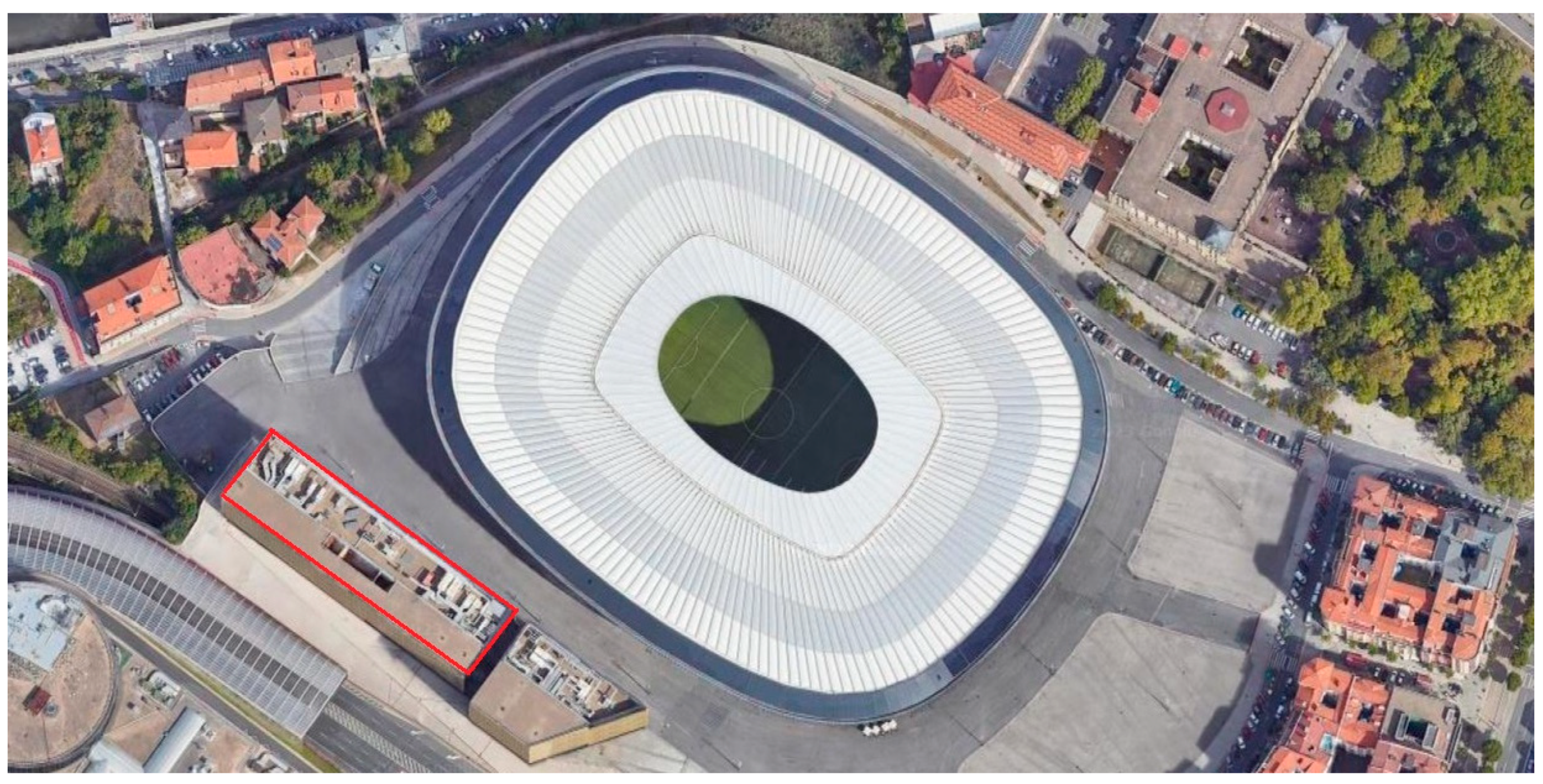

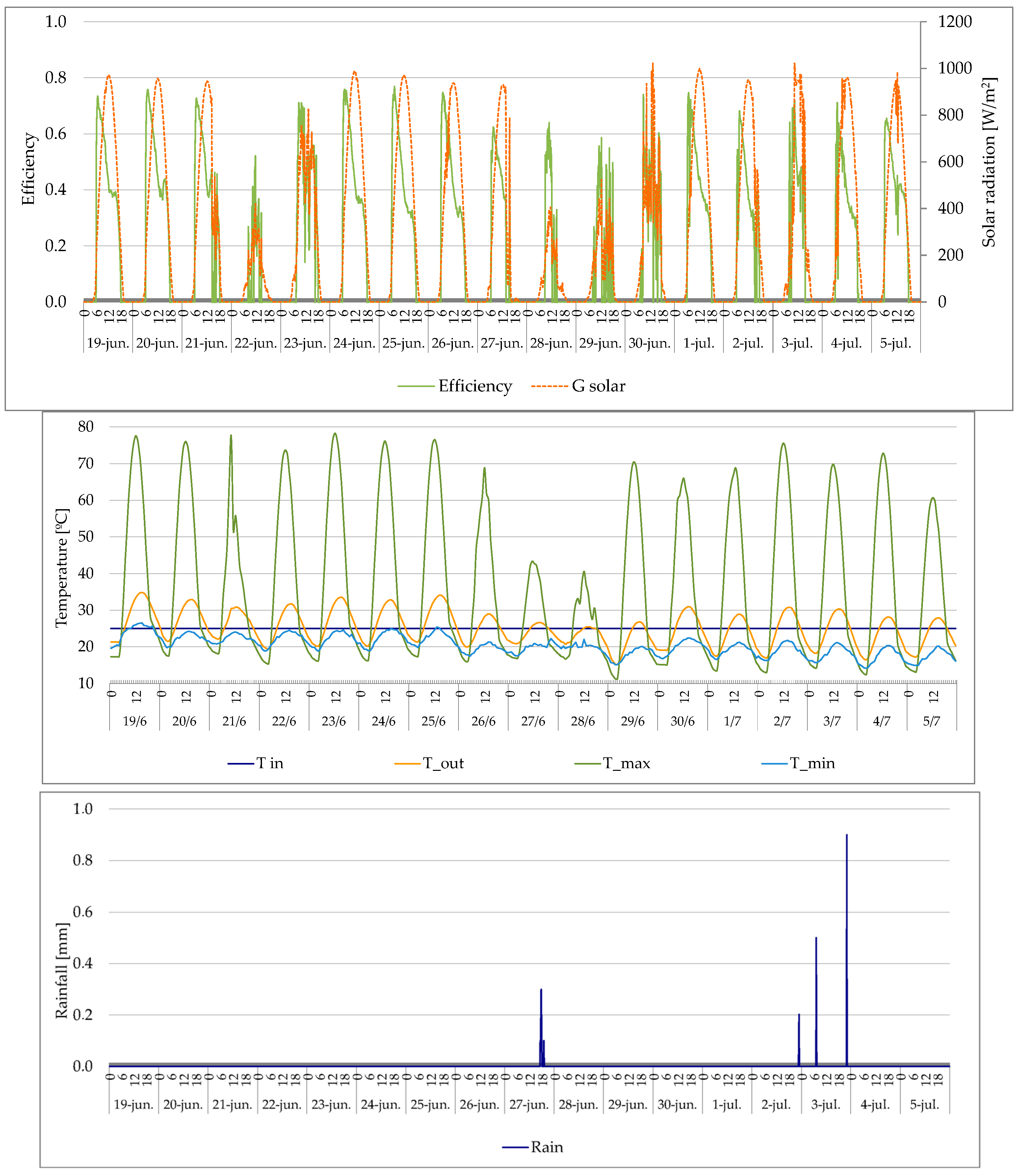
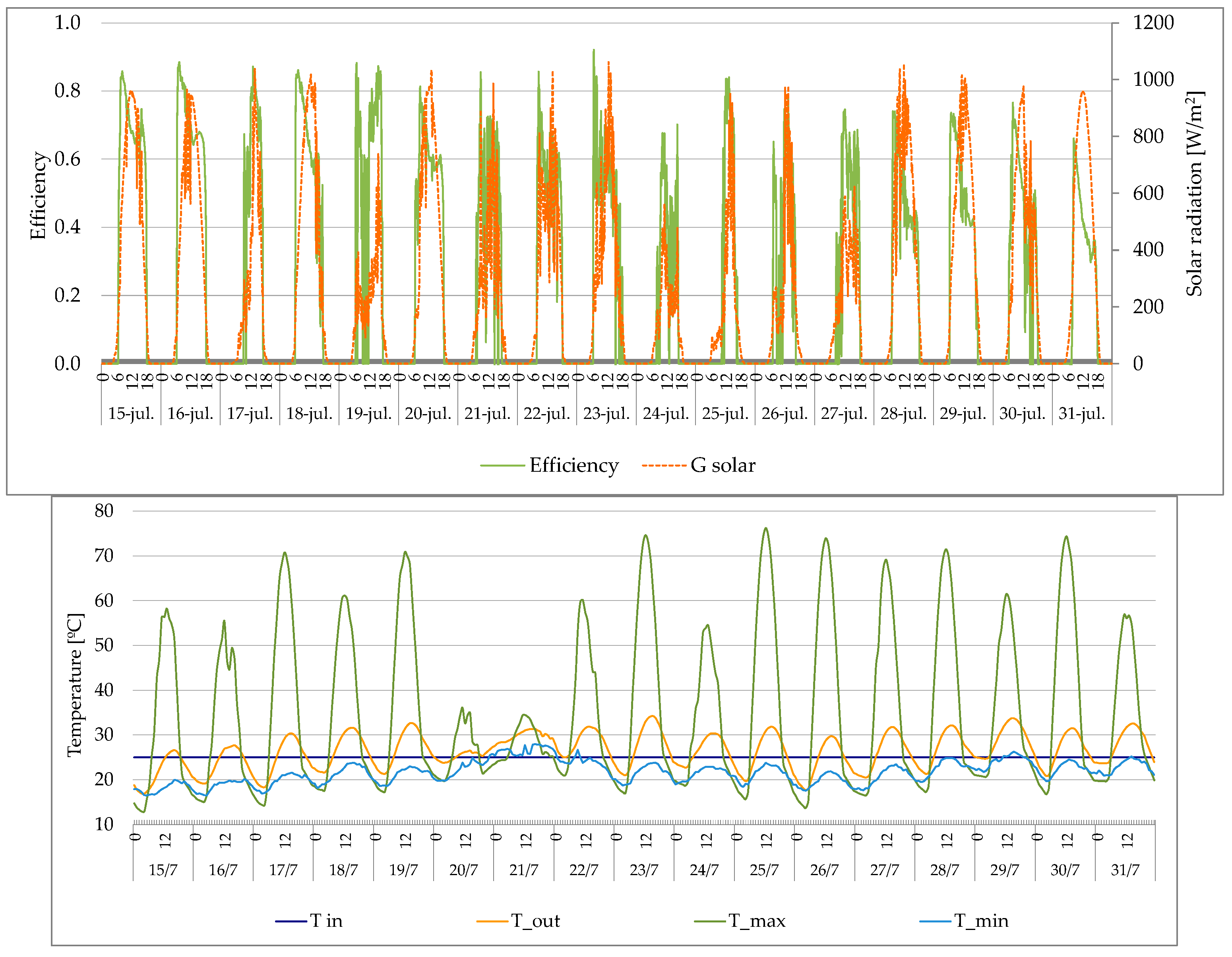
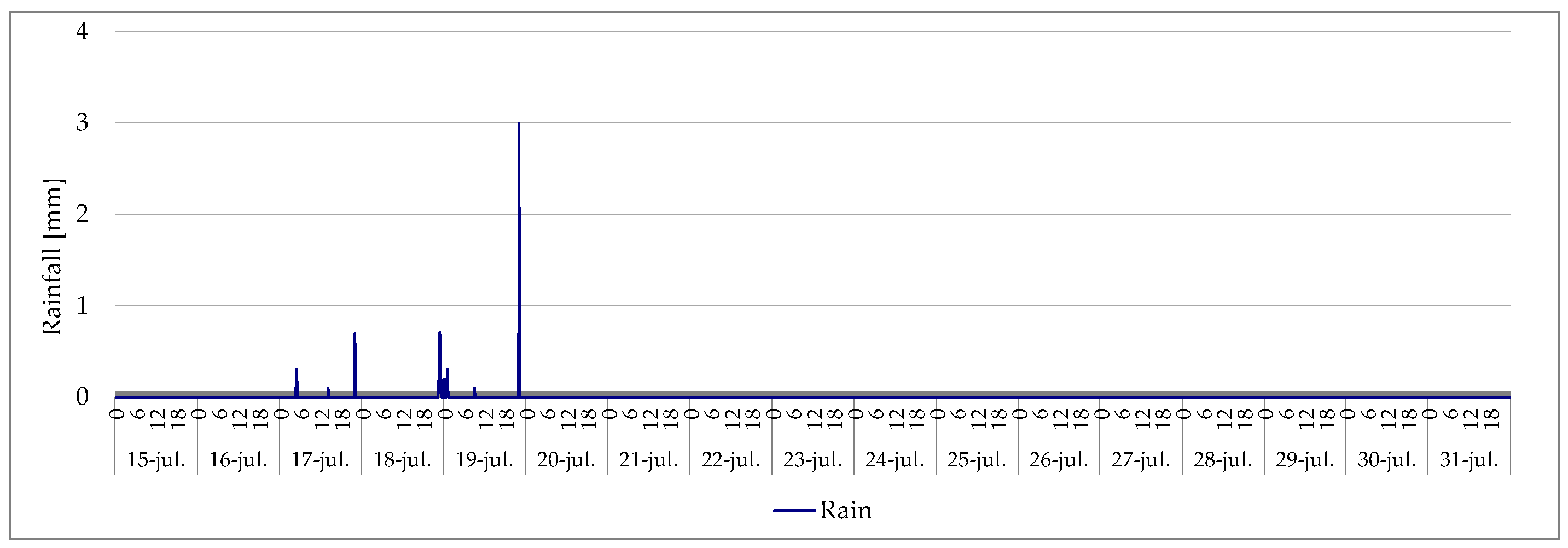
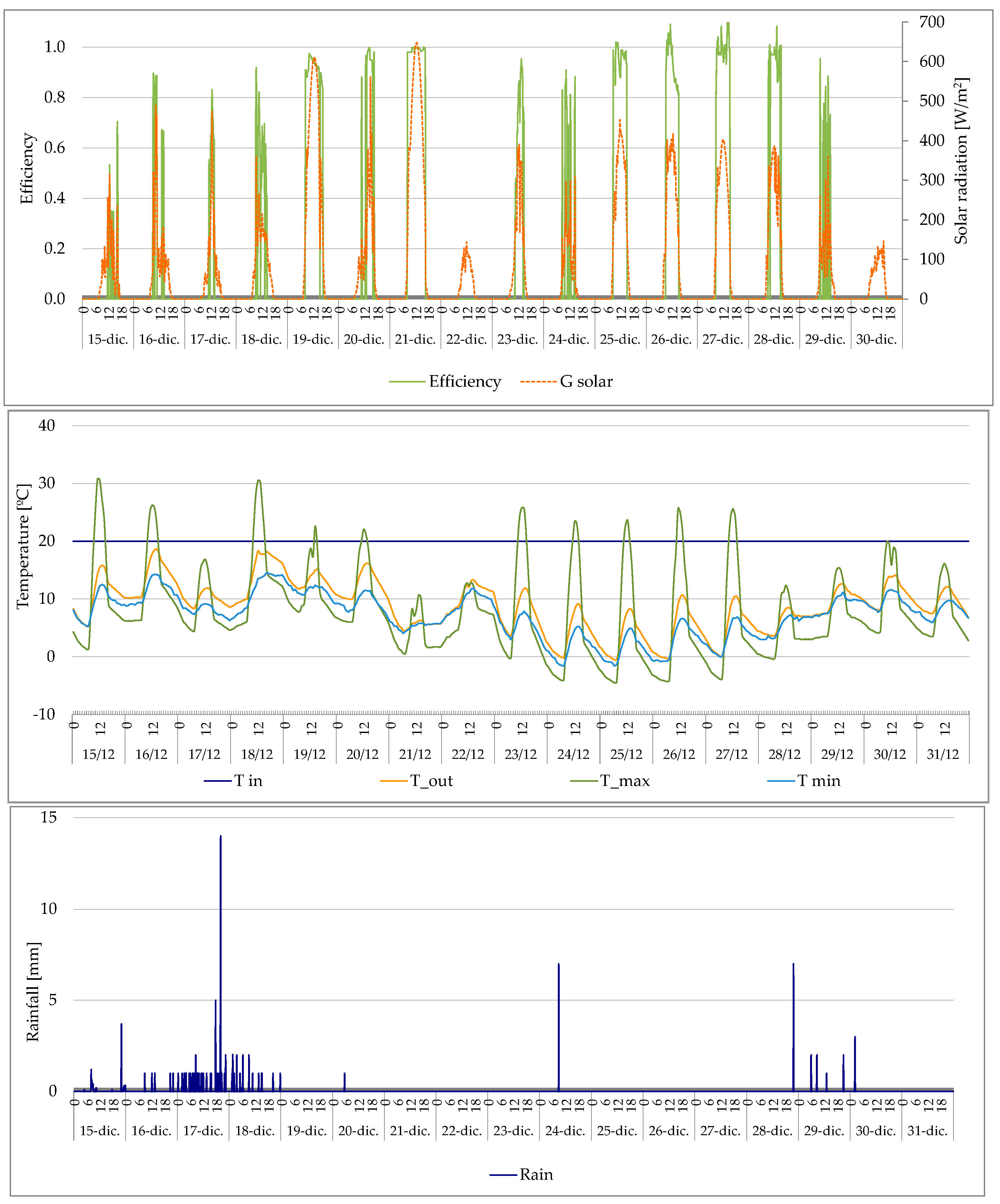

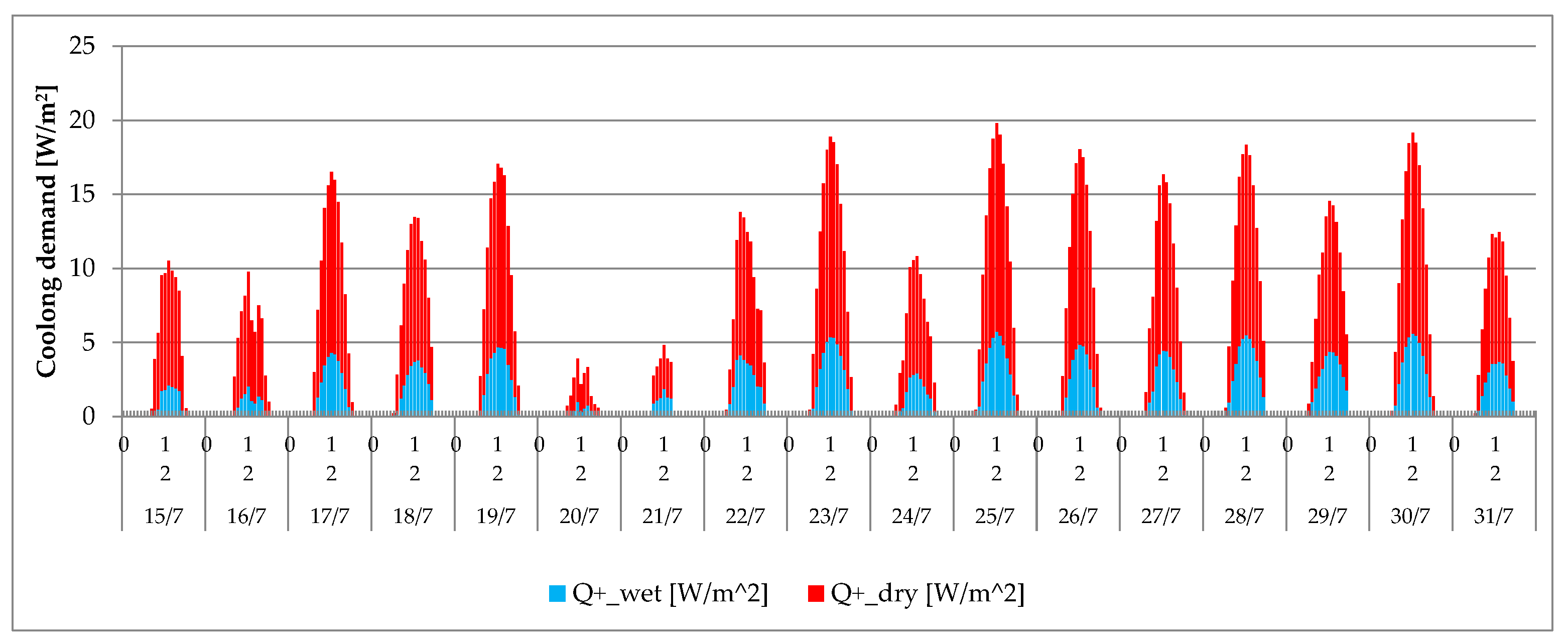
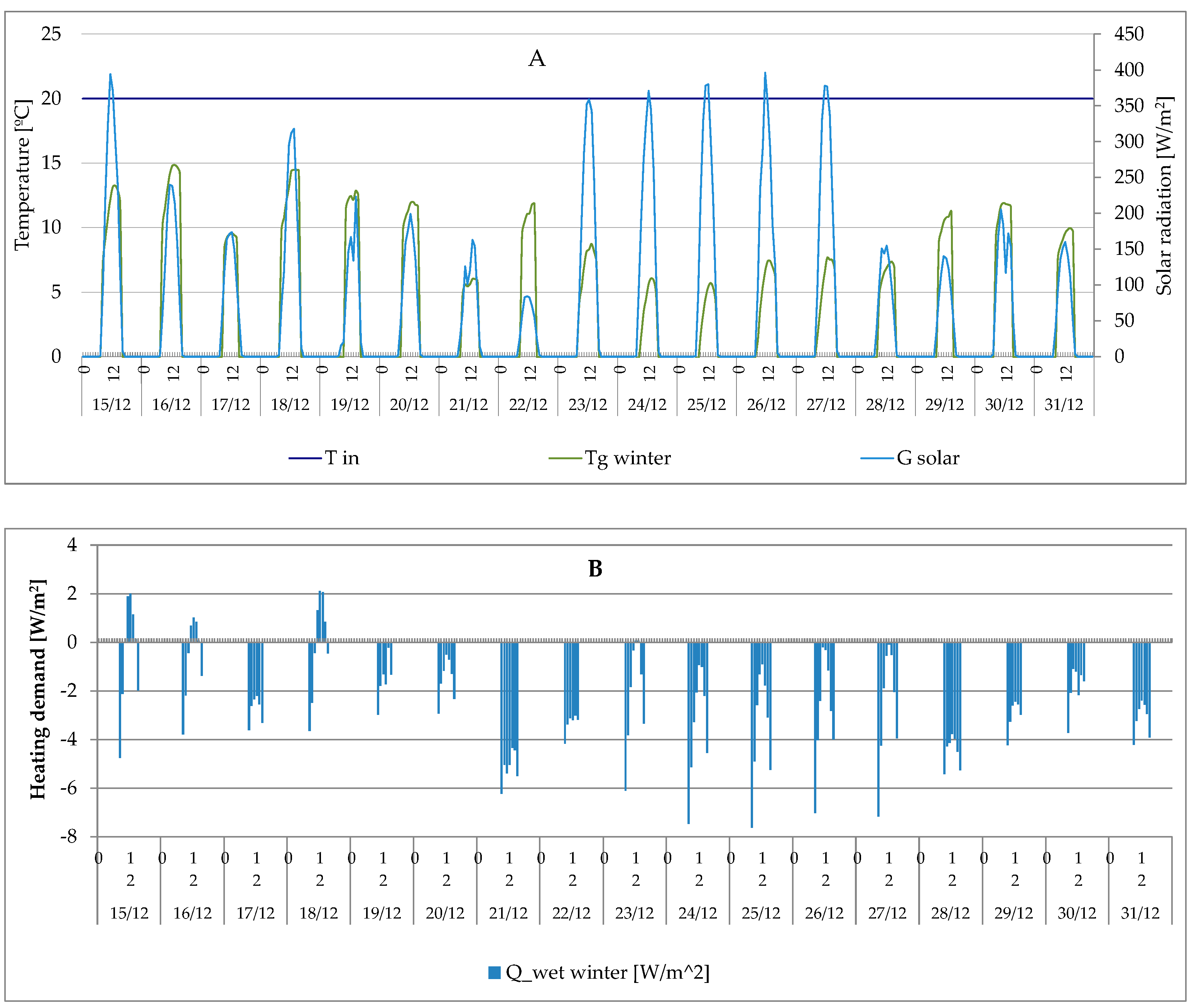
| Sample Number | Organic (No Bread) (kg) | Bread (kg) | Packages (kg) | Total (kg) |
|---|---|---|---|---|
| 1 | 31.8 | 3.7 | 10.0 | 45.5 |
| 2 | 27.2 | 1.5 | 5.6 | 34.3 |
| 3 | 35.7 | 4.2 | 10.9 | 50.8 |
| 4 | 27.4 | 2.8 | 10.0 | 40.2 |
| Average | 30.5 | 3.1 | 9.1 | 42.7 |
Disclaimer/Publisher’s Note: The statements, opinions and data contained in all publications are solely those of the individual author(s) and contributor(s) and not of MDPI and/or the editor(s). MDPI and/or the editor(s) disclaim responsibility for any injury to people or property resulting from any ideas, methods, instructions or products referred to in the content. |
© 2023 by the authors. Licensee MDPI, Basel, Switzerland. This article is an open access article distributed under the terms and conditions of the Creative Commons Attribution (CC BY) license (https://creativecommons.org/licenses/by/4.0/).
Share and Cite
Azkorra-Larrinaga, Z.; Romero-Antón, N.; Martin-Escudero, K.; Lopez-Ruiz, G. Environmentally Sustainable Green Roof Design for Energy Demand Reduction. Buildings 2023, 13, 1846. https://doi.org/10.3390/buildings13071846
Azkorra-Larrinaga Z, Romero-Antón N, Martin-Escudero K, Lopez-Ruiz G. Environmentally Sustainable Green Roof Design for Energy Demand Reduction. Buildings. 2023; 13(7):1846. https://doi.org/10.3390/buildings13071846
Chicago/Turabian StyleAzkorra-Larrinaga, Zaloa, Naiara Romero-Antón, Koldobika Martin-Escudero, and Gontzal Lopez-Ruiz. 2023. "Environmentally Sustainable Green Roof Design for Energy Demand Reduction" Buildings 13, no. 7: 1846. https://doi.org/10.3390/buildings13071846
APA StyleAzkorra-Larrinaga, Z., Romero-Antón, N., Martin-Escudero, K., & Lopez-Ruiz, G. (2023). Environmentally Sustainable Green Roof Design for Energy Demand Reduction. Buildings, 13(7), 1846. https://doi.org/10.3390/buildings13071846






